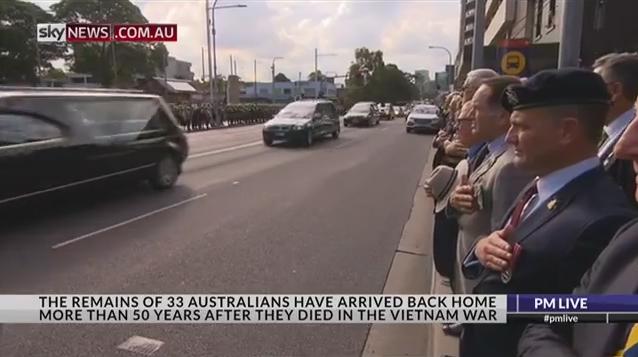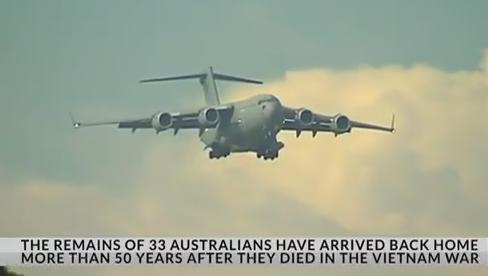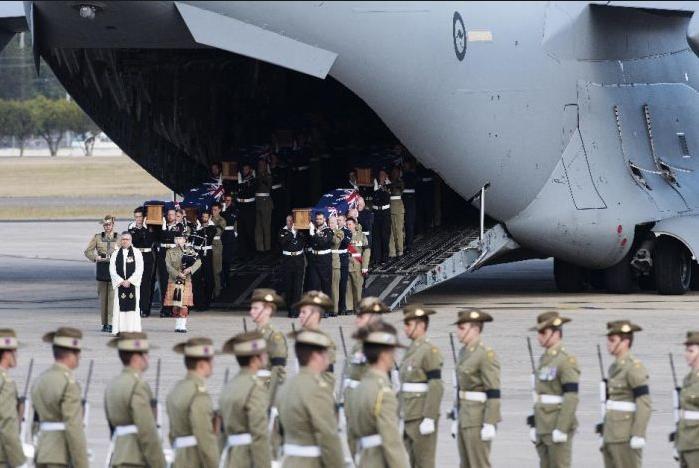Brave young Australians lost their lives in the Vietnam War (1962-75) and the Malayan Emergency (1950-63).
Warrant Officer Kevin Conway, killed during the battle of Nam Dong in South Vietnam on July 6, 1964 was buried in Kranji War Cemetery in Singapore. Initially buried in Saigon, his remains were relocated to Ulu Pandang Cemetery Singapore before being removed again to Kranji.
Some twenty-six Australian service personnel were buried in Terendak Military Cemetery in Malaysia, including WO2 Ronald Lees who had previously served in the Malayan Emergency. Another eight Australian dependants were also buried in Terendak, making a total of 35 Australians buried at the two cemeteries.
 The late Warrant Officer Class II Kevin George Conway
The late Warrant Officer Class II Kevin George Conway
R.I.P.
But yesterday, thirty-three of these Australians were finally returned home to Australian soil and their families are highly thankful. It was the right thing to do. To be congratulated is the Vietnam Veterans Association of Australia NT Branch and its tireless Operation ‘Bring Them Home’ campaign.
“Chip’n away. Wish I could shake more hands – our boys deserve more than this. Chin up to those who’ve donated.”
– Tim Longford
Among those interred were Major Peter Badcoe, Portsea’s first VC recipient and ironically the first OCS Portsea graduate to die on operations along with Private Dal Abbott, a 1RAR soldier killed at the Balmoral battle on May 30, 1968. They are the only two Australians remaining at Terendak, Major Peter Badcoe VC at his family’s request and 1RAR’s Pte Dal Abbot whose family continue to deny his return.
Read More: http://www.bringthemhome.org.au/brief-background/lest-we-forget
More than 160 relatives gathered at Sydney’s Richmond RAAF air base yesterday as two Royal Australian Air Force C-17A Globemaster transport aircraft landed bearing the 25 veterans and eight dependant family members from the two cemeteries.
This repatriation seeks to ensure that all Australian service personnel who died in the Malayan Emergency and the Vietnam War are to be finally treated equally – or at least make up for past mistakes. Up until 21 January 1966, Australian service personnel who died overseas after the Second World War were interred in the closest practicable ‘Commonwealth’ cemetery, ‘then ‘normal practice’, unless the next of kin elected to have the remains returned to Australia at their own expense. This return home of the bodies was part of a government-funded programme announced by former prime minister Tony Abbott and is one of the largest in Australian history.
Draped in Australian flags, the coffins were led by a chaplain, lone piper and drummer, and carried by Australian Defence Force men and women, into a private ceremony where the family members grieved.
Governor-General Sir Peter Cosgrove spoke at the ceremony, saying the repatriated veterans and civilians were a precious part of the national community and now an honoured part of the Australian military family. The first one killed in Vietnam, was WO2 William Hacking on the 1st June 1963, was brought home at Government (public) expense. But 35 weren’t. The Army callously demanded £500, a small fortune by today’s standards to repatriate remains to Australia. The family couldn’t afford it. It was equivalent then to half a year’s wage ($30,000 today). And they’d just lost their loved one.These Soldiers fought for their Country and made the Supreme Sacrifice and the Government of the Day wanted the NOK and Families to pay for their repatriation back to Australia.
These families had no choice, either pay up or be buried in Malaysia. This was a terrible way to treat bereaved families, and it caused further heartache as these relatives had the extra burden of that huge guilt of not being able to afford to bring their loved ones home.
Fifty two years later, yesterday and happily paid for by Australian taxpayers, 33 were returned to Australia. In 33 coffins, they were driven in 33 hearses from the air base in procession from RAAF Base Richmond to Parramatta, where members of the public were able to gather to pay their respects. Thousands lined the route.
The names we can find of the 35 – may be someone who knows more can contact us. (Read More: http://www.vvaa.org.au/terendak.htm):
- Warrant Officer Two Kevin G. Conway, age 35, killed 6 Jul 1964, Australian Army Training Team Vietnam
- Private Dal E. Abbot, age 21, killed 30 May 1968, 1st Battalion, Royal Australian Regiment
- Private Norman G. Allen, age 21, killed 10 Nov 1967, 7th Battalion, Royal Australian Regiment
- Private Gary A. Archer, age 22, killed 4 Feb 1969, 9th Battalion, Royal Australian Regiment
- Major Peter J. Badcoe VC, age 33, killed 7 April 1967, Australian Army Training Team Vietnam
- Lieutenant Robert Birse, age 23, killed 10 Dec 1967, 4th Field Regiment, Royal Australian Artillery
- Corporal Robert W. Bowtell, age 33, killed 11 Jan 1966, 3rd Field Troop, Royal Australian Engineers
- Sergeant Ronald T. Carroll, age 31, killed 4 Aug 1968, 3rd Battalion, Royal Australian Regiment
- Gunner Thomas W. Checkley, age 28, killed 5 Aug 1966, 131st Divisional Locating Battery
- Private Christopher Clark, age 20, killed 8 Jan 1966, 1st Battalion, Royal Australian Regiment
- Private Ronald E. Field, age 22, killed 9 Oct 1965, 1st Battalion, Royal Australian Regiment
- Warrant Officer Two John Garrigan, age 40, killed 27 Dec 1968, Australian Army Training Team Vietnam
- Warrant Officer Two Maxwell P. Hanley MM, age 31, killed 20 Feb 1967, Australian Army Training Team Vietnam
- Corporal Reginald H. Hillier MID, age 26, killed 29 Nov 1965, 1st Battalion, Royal Australian Regiment
- Trooper Tony Holland, age 21, killed 7 Jul 1966, 1st Armoured Personnel Carrier Squadron
- Private Neville W. Horne, age 19, killed 8 Jan 1966, 1st Battalion, Royal Australian Regiment
- 2nd Lieutenant Allan D. Jellie, age 22, killed 3 Dec 1969, 161st Independent Reconnaisance Flight, RAAF
- Capt. Barry C. Donald DSM, age 30?, killed 3 Dec 1969, 161st Independent Reconnaisance Flight, RAAF
- Warrant Officer Two Ronald V. Lees, age 37, killed 13 Jan 1966, Australian Army Training Team Vietnam (also served in Malaya)
- Corporal John G.S. Pearce, age 22, killed 14 May 1966, 1st Battalion, Royal Australian Regiment
- Warrant Officer Two Thomas D. Phillips, age 38, killed 20 Mar 1966, Australian Army Training Team Vietnam
- Lance Corporal Thomas Ross, age 25, killed 12 Oct 1965, 1st Battalion, Royal Australian Regiment
- Lance Corporal Arthur Ruduss, age 29, killed 12 Jun 1966, Headquarters, 1st Australian Task Force
- Gunner Thomas Simpson, age 27, killed 9 Dec 1965, 105 Field Battery, Royal Australian Artillery
- Corporal Francis J. Smith, age 25, killed 21 Sep 1965, A Company, 1st Battalion, Royal Australian Regiment
- Private Mervyn A.F. Wilson, age 29, killed 8 Jan 1966, 1st Battalion, Royal Australian Regiment
- Lieutenant David Brian, age 25, killed 5 Mar 1964, 1st Battalion, Royal Australian Regiment
- ?
- ?
- ?
- ?
- ?
- ?
- ?
- ?
“No greater love hath any man than this that he lay down his life for a friend”
Lest We Forget
 The funeral procession through Parramatta. Welcome Home.
The funeral procession through Parramatta. Welcome Home.
A private service for the families of the 33 war veterans was held. Over the next three weeks, the families will hold their own private burial services across the country and finally lay their loves ones to rest at home in Australia.
“It’s lovely it’s happening and I feel peaceful about that, but it’s very traumatic,” Lt Brian’s widow Sara Ferguson said of the day, which came two years after she began campaigning for his body to be returned home. She was 21 and pregnant when her husband died.
“It was leaving him there that was the hardest part. I had to walk away and come home without him, because I was over there,” she said.
David Brian will be reinterred in the Anzac Section Pinaroo Lawn Cemetery, Brisbane on June 10, with members of his platoon present.
Cpl Reg Hillier (MID) was killed in action serving with 1st Battalion Royal Australian Regiment at Vo Dat, Binh Tuy Province, aged 26. He had served in Vietnam 187 days. Reg was the son of Hedley Hillier and the brother of Barbara, Margaret and Jim. Reg was buried at Terendak Military Cemetery, Plot CoE, Row A, Grave 14. His father’s wish has finally been honoured: “I want my dead son bought home”.(NT News 1965 Dec 3). Nikki Ross (great neice) “Reg was buried overseas with not one family member in attendance, and all we have are photos of his funeral service and his headstone which is the one thing the Government did do.”
Reg Hillier was the only Northern Territorian to be killed in Vietnam. The VVAA NT Rural Sub Branch hall is named after Reg – Reg Hillier House. There is a park in Palmerston in his memory and a plaque on the Darwin Cenotaph.
The Malayan Emergency was declared on 18 June 1948, after three estate managers were murdered in Perak, northern Malaya by guerrillas of the Malayan Communist Party (MCP), an outgrowth of the anti-Japanese guerrilla movement which had emerged during the Second World War.
Australia’s involvement in the Emergency went from 1950 involved the RAAF and the Australian Regular Army – 2RAR, then 3RAR and then 1RAR in jungle warfare supporting the British and Malay government against the communist insurgents. Thirty-nine Australian servicemen were killed in Malaya, although only 15 of these deaths occurred as a result of operations, and 27 were wounded, most of whom were in the Army.
‘This year is the 50th anniversary of the Battle of Long Tan, Australia’s costliest day in the Vietnam War. Eighteen Australian soldiers were killed in the Battle of Long Tan – 17 from Delta Company and one from the 1st APC Squadron, whilst another 24 men were wounded.
From the time of the arrival of the first members of the Team in 1962 almost 60,000 Australians, including ground troops and air force and navy personnel, served in Vietnam; 521 died as a result of the war and over 3,000 were wounded. The war was the cause of the greatest social and political dissent in Australia since the conscription referendums of the First World War. Many draft resisters, conscientious objectors, and protesters were fined or jailed, while soldiers met a hostile reception on their return home.
More than 100,000 Australians have died in wars prior to 21 January 1966. Their graves and memorials lie in 84 countries around the world and are maintained in perpetuity through the Office of Australian War Graves.’ (Australian War Memorial)
R.I.P.


